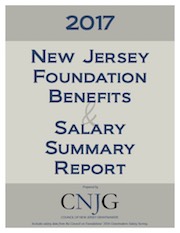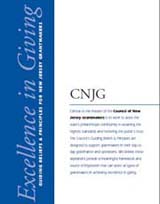Site Search
- resource provided by the Forum Network Knowledgebase.
Search Tip: Search with " " to find exact matches.
The National Center for Family Philanthropy and Youth Philanthropy Connect, a program of the Frieda C. Fox Foundation, have joined together to bring new resources to the field of philanthropy focused on engaging the next generation of donors and family members. Igniting the Spark: Creating Effective Next Gen Boards is the first publication of its kind, offering a comprehensive overview of the growing practice among family foundations and donor advised fund holders of using next generation boards.
The issue brief outlines creative options for involving children as young as 8 in family philanthropy. It is supplemented by case studies of seven foundations using next gen boards and other approaches for engaging youth in philanthropy. Throughout both resources, the voices of next gen donors describe what works — and what doesn’t — providing family members and staff with guidance and insights new to the field.
Directors & Officers liability insurance provides financial protection for a foundation and its directors, officers, employees, and volunteers in the event of a lawsuit. CNJG offers its members the D&O liability insurance program provided through Aon Association Services, underwritten by The Hartford and endorsed by the United Philanthropy Forum. A discount is available to foundations with current membership with CNJG.
Fiduciary Liability and other coverage is also available to members at a discounted rate. Coverage is available in all states. Brokers can access the Forum’s D&O program through Aon Association Services.
Learn more using the documents below, on the Aon website or by contacting Jason Tharpe, program administrator at Aon Affinity, at 202-429-8561. To obtain the discount, foundations should let Aon know they are a member of CNJG, a member of the United Philanthropy Forum.
To answer the basic question of how many active family foundations are planning to spend down or exist in perpetuity (or have not yet made a decision), and to examine foundations’ motivations and decision-making, the Foundation Center, in collaboration with the Council on Foundations and with additional assistance from the Association of Small Foundations, launched a study of family foundations in 2008. This report presents the full range of study findings, which are based on survey responses from 1,074 family foundations.
How the government can partner with impact investors to unleash new capital, talent and energy for maximum impact.
A CNJG member queried our listserves on what online grants management system members use and would recommend for a small foundation. CNJG compiled these responses, and listed the different systems that members do use.

A CNJG corporate member asked for help with the scenario in which a corporate policy of not supporting religious organizations in their grantmaking, causes problems helping during a disaster in an urban or rural area, when the program that is delivering the disaster relief is based within a church. They want to work with those programs (a church serves as the program’s fiscal sponsor) who support efforts for hunger, homelessness, substance abuse recovery, racial equity, etc. as long as they do not discriminate and do no limit it to their own congregations. The request for policy samples to work around this religious organization hurdle as long as there is no discrimination or funding the actual church’s worship, was compelled by CNJG staff and is listed here.
This report highlights three philanthropic efforts to build the capacity of local communities in the West - The Ford Family Foundation’s Ford Institute Leadership Program, the Northwest Area Foundation’s Horizons Program, and the Orton Family Foundation’s Heart and Soul Community Planning Program.
Food is essential. But how often do you consider where your food comes from?This issue of What Funders Need to Know from the Washington Regional Association of Grantmakers explores the stages of the food system, from production all the way to disposal. Why is this important to philanthropy?
Because hunger, food insecurity, nutrition-related chronic disease, the health of resource lands and waterways, wages, and equal opportunity in the food economy all converge in our regional food system.
A working glossary of terms to help shape a common language for work in Community Capacity. This glossary is intended to help promote philanthropy's roles in building community capacity by defining core concepts and closely related terms.
Novartis benchmarked Employee Crisis Programs, and asked fellow corporate funders via the corporate funders listserve to answer the questions below.
- If you have an Employee Crisis Program, what is the name
- Do you manage the program internally or thru a 3rd party? If you use a 3rd party, can you share their name/website and any good/bad experiences.
- Do you only support disasters or other hardships as well?
- What is the average percentage of your employees that apply for aid?
- What is your minimum and maximum funding?
- What is the average amount of aid?
- Do you provide aid directly to the employee and/or vendors?
- Do you allow employees to donate to your fund? If so, how do you promote awareness and what is the employee donation participation rate? Do you match these donations?
- Where does the program reside (CSR, Foundation, HR)?
- Please share guidelines and applications, if possible.
- Please share any other insights.
Strategic asset allocation is arguably one of the most important, yet least advanced, aspects of investing. The Investment Strategy Group (ISG) in the Goldman Sachs Investment Management Division has developed a new approach to strategic asset allocation, which leverages the idea that long-term investment returns derive from multiple distinct sources called “return-generating factors.” This multi-factor approach is designed to help investors better understand the key sources of long-term return across asset classes and to increase the precision of long-term risk and return estimates. It also provides investors with a new way to think about portfolio diversification, allowing them to focus not only on diversification across asset classes but also
on diversification across the underlying sources of return.
Horizon Blue Cross Blue Shield of New Jersey, through its philanthropic arm, The Horizon Foundation for New Jersey, issued $555,000 in grants to 15 non-profit organizations for health, cultural programs and disaster relief throughout New Jersey during the third quarter of 2021.
The Foundation’s mission is to support organizations that make New Jersey healthier.
A total of $50,000 in disaster relief grants was awarded to the following organizations to support designated FEMA disaster areas and fill the gaps in the response effort:
- $25,000 to Community FoodBank of New Jersey
- $25,000 to ReNew Jersey: Ida Relief
Other grants issued in the third quarter include:
AtlantiCare Foundation, through the Community Foundation of New Jersey, in Morristown, received a $50,000 grant to support the Atlantic City Patient Transportation project, which provides free, easily accessible and reliable transportation for low-income patients in Atlantic City, using the health system’s services.
Diabetes Foundation, in Hackensack, received a $30,000 grant to support Improving Health Outcomes through Education and Guidance, a prevention and education program provided in English and Spanish, for patients with pre-diabetes and diabetes.
Food Bank of South Jersey, in Pennsauken, received a $25,000 grant to support Prevent T2, an evidence-based intervention for seniors designed to delay and/or prevent the onset of Type 2 diabetes.
Garden State Equality Education Fund, in Asbury Park, received a $25,000 grant to support the Adverse Childhood Experiences (ACEs) Self-Healing Community Model, which addresses the impact of trauma and ACEs on mental and physical health among LGBTQ+ and other marginalized communities in Camden.
George Street Playhouse, in New Brunswick, received a $75,000 grant to support the production of Anytown, a musical drama for students in grades 7-12, focusing on the challenges and consequences of opioid abuse and its impact on teens and families.
Greater Newark Health Care Coalition, in West Orange, received a $50,000 grant to support the Greater Newark Community Health Worker (CHW) Learning Collaborative, a project that promotes the growth, leadership and interconnections of CHWs in the Greater Newark region through monthly meetings, resource sharing and training.
Hopeworks ‘N Camden, in Camden, received a $20,000 grant to support Returning Stronger, which is focused on the development of a youth-built, youth-focused, easy-to-access website, to help young people find relevant mental health resources.
Mercer Council on Alcoholism & Drug Addiction, in Trenton, received a $20,000 grant to support the Community Oriented Recovery Effort (CORE), a pilot project to create and promote a larger, more inclusive space for those in the recovery community in Trenton and the surrounding area.
Millhill Child and Family Development Corporation, in Trenton, received a $20,000 grant to support Eat Right, Keep Moving, an obesity education and prevention program that aims to build a Culture of Health within the communities that Millhill serves.
Newark Boys Chorus School, in Newark, received a $40,000 grant to support the school’s music and concert touring programs, as well as academic initiatives.
The Newark Museum of Art, in Newark, received a $100,000 grant to support The Horizon Foundation Community Days, which occur once a month and provide free diverse programming for all ages.
Saint Vincent Academy, in Newark, received a $25,000 grant to support the Horizon Blue Cross Blue Shield of New Jersey Leadership Promise Scholarship, which provides one four-year scholarship to a Greater Newark-area student.
St. Benedict’s Preparatory School, in Newark, received a $25,000 grant to support the Steven Grossman Student Counseling Center, which provides students with mental health education, resources and services.

This includes insights and tips related to board governance, legal compliance, grantee communications, fiscal responsibility, public disclosure, and many other key areas of foundation governance and operations. It is intended to serve as a practical resource to assist foundations in their grantmaking.
